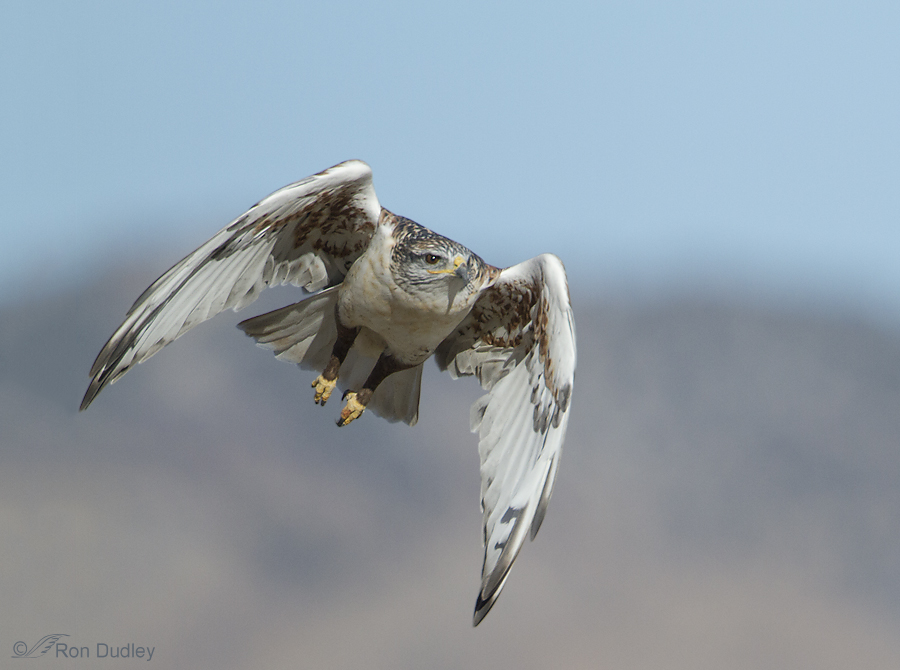The Ferruginous Hawk is the largest, most powerful buteo in North America. They have a broad chest, wide gape, large head and long, narrow-tipped wings. Unlike most other buteos they often perch on the ground. Their huge nests, typically constructed in isolated trees or on cliffs, were often constructed of bison bones and wool before the elimination of that massive animal from the western plains. This species is often compared to the Golden Eagle with which it has much in common and they are fully deserving of their apt scientific name, Buteo regalis.

1/4000, f/6.3, ISO 500, 500 f/4, 1.4 tc, natural light, not baited, called in or set up
This bird had been perched on an old fence post in Utah’s west desert (background is the Stansbury Mountains) and I was able to capture it in flight soon after it lifted off. I like the blood on the left foot and the somewhat unusual wing position as it took off mostly in my direction. This wing position is seldom seen in photographs because the wing would obscure the head in the much more common side view. Typically these birds don’t take off toward the photographer from a low perch.
Ron


Thanks once again Ron.It must be an take an enormous effort for the Ferruginous Hawk ( or any bird of prey that size) to take off from a position on or close to the ground. Awesome photo !
Thanks, Ron. “Beauty-O” regalis. BTW,we are having a “good” Ferruginous Hawk year – I took a small group to the Klamath Basin last weekend and we saw 64 ferrugies, including 2 rufous morphs and one true dark morph. Sure wish I was a photographer…
Cheers,
Dick
Wow, that’s an impressive number of ferrugs, Dick. It’s not too late to join the photog cadre, ya’ know…
No wonder that I, and many others, having found your blog develop an addiction. Your photos are awe-inspiring, your commentary always a joy and educational, and the comments you receive are also an on-going education. A big thank you to you, and to people who comment here.
The folks who comment here are a huge addition to the blog, Elephant’s Child. You hit the nail on the head.
I anxiously await the day when I can see one of these magnificent birds in the field. Fabulous photo with great info from you and an interesting tidbit about the size of the feet from Mark. I understand Melissa’s excitement at discovering your blog–I shared the same excitement when I discovered your blog and rarely miss a post. It greatly enhances my days.
Thank you so much for the kind comment, Sharon.
Whoa, what a fantastic shot of an incredible raptor! I just found your blog, and you can be I’ll be back to enjoy it often. Thanks for sharing!
Welcome, Melissa. Hope to “see” you around…
Gorgeous! And the info from Mark is interesting.
Thank you, Tana. I agree about Mark’s info.
Ron,
Another crackin shot! Nice set up too with the fast shutter speed.
I’m glad you noticed that SS Chris. I like to error on the high side (as long as I don’t have to crank the ISO up too much)for these types of shots.
Hi Ron,
From a falconry standpoint, the Ferrug is perhaps the least understood and underutilized buteo in North America. I spent several days trying to catch an immature female in the early ’90s to try to train to hunt from the soar to hunt pheasants. I wasn’t sucessful in catching one, but several have been trained since then. Their only downside is that they have tiny feet for their size. A male Red Tail has larger feet than a female Ferrug!
It is intersting to note that they are one of the few raptors that will hunt cooperatively. One bird will make very obvious passes on the edge of a prairie dog town and while all of the prairie dogs are sitting up watching the first Ferrug, a second one will attack from behind. This has been documented too many times to be just a coincidence.
Thanks for the beautiful pictures.
Mark
Fascinating stuff, Mark – especially that bit about comparing the feet of red-tails and Ferrugs. Your contributions here are always so interesting!
What a marvelous shot! Thanks for sharing it!
Thanks, Charlotte.